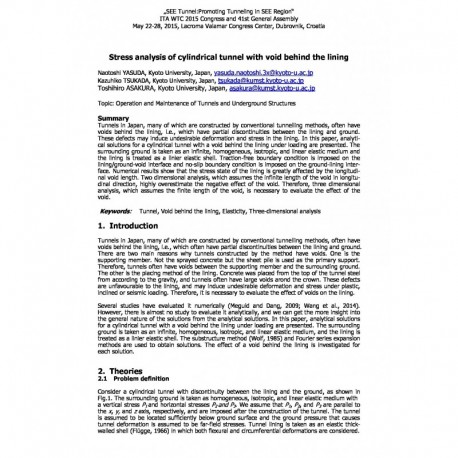Cart
0
0
No document
0,00 €
Total
Document successfully added to your shopping cart
Quantity
Total
There are 0 items in your cart.
There is 1 item in your cart.
Total documents
Total shipping
To be determined
Total
Search & filter
Search for a publication
Search & filter
Viewed documents

Stress analysis of cylindrical tunnel with void behind the lining
wtc2015_full_yasuda
N. Yasuda / K. Tsukada / T. Asakura
Tunnels in Japan, many of which are constructed by conventional tunnelling methods, often have voids behind the lining, i.e., which often have partial discontinuities between the lining and ground. There are two main reasons why tunnels constructed by the method have voids. One is the supporting member. Not the sprayed concrete but the sheet pile is used as the primary support. Therefore, tunnels often have voids between the supporting member and the surrounding ground. The other is the placing method of the lining. Concrete was placed from the top of the tunnel steel from according to the gravity, and tunnels often have large voids arond the crown. These defects are unfavourable to the lining, and may induce undesirable deformation and stress under plastic, inclined or seismic loading. Therefore, it is necessary to evaluate the effect of voids on the lining. Several studies have evaluated it numerically (Meguid and Dang, 2009; Wang et al., 2014). However, there is almost no study to evaluate it analytically, and we can get the more insight into the general nature of the solutions from the analytical solutions. In this paper, analytical solutions for a cylindrical tunnel with a void behind the lining under loading are presented. The surrounding ground is taken as an infinite, homogeneous, isotropic, and linear elastic medium, and the lining is treated as a linier elastic shell. The substructure method (Wolf, 1985) and Fourier series expansion methods are used to obtain solutions. The effect of a void behind the lining is investigated for each solution.


